
The Links Between Magic Mushrooms And Christmas
It may seem like wishful thinking to assert that magic mushrooms could have influenced much of what we consider to be Christmas tradition—but read on, and you may find that it's not so outlandish after all!
Christmas traditions go back a long way, to and beyond Saint Nicholas, aka Santa Claus. Usually, Christmas is associated with Christianity and, to a lesser extent, Coca-Cola, which is rumoured to have given Christmas its red and white colouration.
But what if Siberian psychedelic practices also influenced the imagery of the Christmas we know today? Read on to discover the role that Amanita muscaria (fly agaric) mushrooms may have played in the conception of modern Christmas.
What do psychedelics have to do with Santa Claus and Christmas?
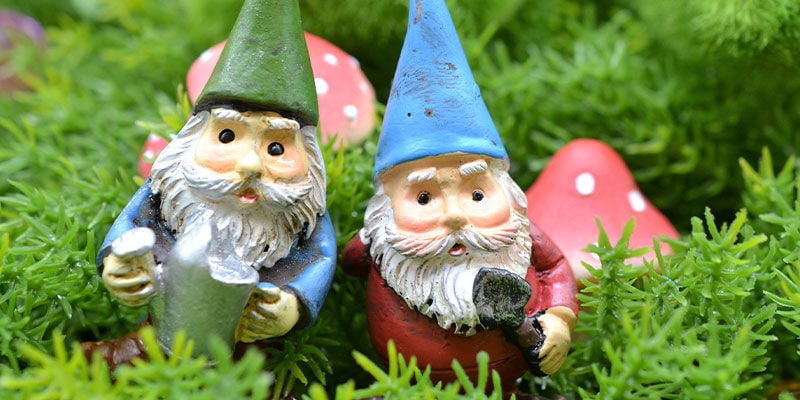
It may initially sound like a stretch to claim that much of the imagery and narrative surrounding Christmas has psychedelic origins—but soon you might be a little less doubtful.
In traditional practice, the shamans of the Koryak and Kamchadal peoples (located in the Russian Far East) would dress up to emulate the unique colouration of the fly agaric mushroom at the winter solstice, which begins on December 21st—the shortest day of the year—and ends on December the 25th, when the day begins to grow longer.
It is said that they would use this mushroom to fly upon a sleigh toward the North Star, where they would gather information about the coming year. And then, upon returning, they would descend through the opening at the top of their yurt (a tent-like structure made of felt) through which the chimney extends.
Sound familiar yet?
What’s more, fly agaric mushrooms have a famous red colouring, with white dots. It just so happens that Santa Claus has a famous red and white colouring, made popular by Coca-Cola. But what if the inspiration for this dates back much further?
What is the Amanita muscaria (fly agaric) mushroom?
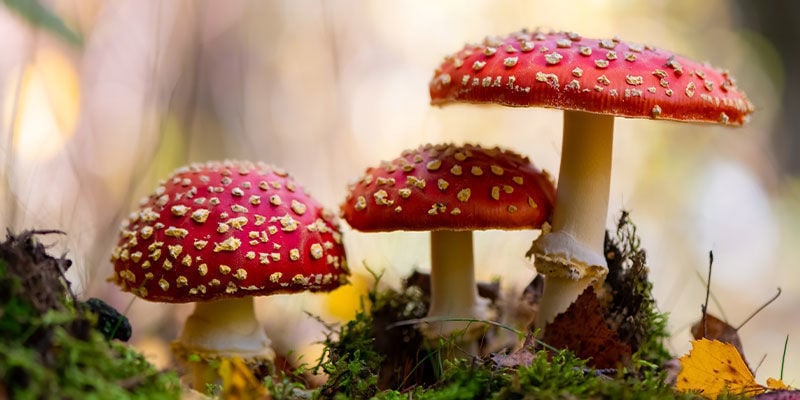
Amanita muscaria is a species of mushroom that grows across Europe, Asia, and North America. It is most commonly found growing at the base of pine and birch trees, with which it has a symbiotic relationship—but more on this shortly.
There are several varieties of fly agaric, some of which are not true Amanita muscaria at all. All contain ibotenic acid and muscimol, which have strong hallucinogenic properties if consumed. However, these toadstools are also toxic and poisonous, and must therefore be properly prepared if they are to be consumed. If they are eaten fresh and raw, you are unlikely to die, but you can become very ill.
Amanita muscaria has a history of religious usage within a variety of cultures, including the above mentioned, as well as the Sami people of northern Europe. The consumption of fly agaric for psychedelic purposes has, traditionally, gone hand in hand with reindeer. All will become clearer shortly.
Due to its symbiotic relationship with pine and birch roots, Amanita muscaria cannot be cultivated, but only foraged for in the wild.
What are the effects of Amanita muscaria?
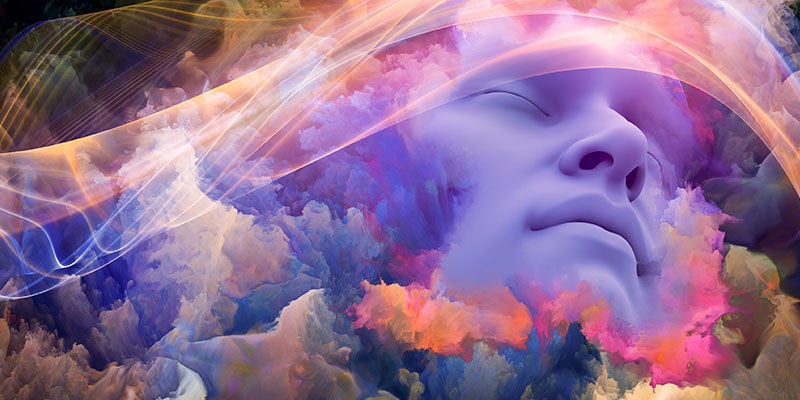
The effects of fly agaric are broad and varied. This depends, in part, on how the mushroom is taken.
Muscimol is the active ingredient in fly agaric mushrooms, and it appears to be GABAergic. This means that it affects the brain’s GABA receptors. In this sense, despite being a “magic mushroom”, it is not similar to classic psychedelics, which tend to affect the serotonin 5-HT2A receptors.
Effects include:
- Synaesthesia
- Lucid dreaming
- Delirium
- Trance-like states
- Nausea
- Euphoria
- Sedation/stimulation (it can have paradoxical effects)
- Out-of-body experiences
- Muscle twitching and tremors
The effects peak at around 3 hours, and last for anywhere between 10 and 24 hours.
4 ways magic mushrooms have potentially influenced Christmas
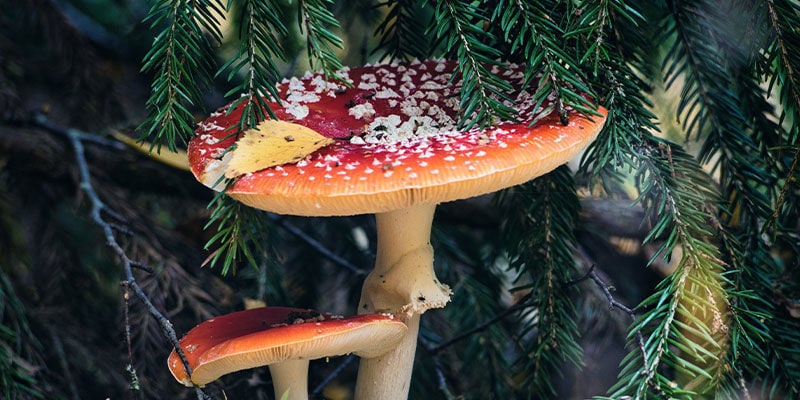
It’s probably already clear how these mushrooms and the practice surrounding them may have influenced modern Christmas, but let’s dive in a little deeper.
Flying reindeer (and red noses)
To avoid the poisonous effects of fly agaric mushrooms, some cultures practised feeding them to reindeer, and then drinking their urine.
Why? Because reindeer are immune to the toxic effects of the mushrooms, and pass the muscimol into their urine. So if you drink their urine, you can experience the full effects of the psychoactive compound without suffering the ill effects of the whole mushroom.
For this reason, reindeer (central to many of these cultures’ existence) also came to be associated with the consumption of fly agaric mushrooms, and therefore with winter solstice ceremonies.
A little more of a stretch—but still plausible—it could be that Rudolph’s famous red nose was initially inspired by Amanita muscaria.
Magic mushrooms and the winter solstice
As mentioned, these practices were specific to the winter solstice, which happens to coincide with Christmas.
It is generally accepted that Christianity adopted the 25th of December as the birth date for Jesus as it represented the coming of the new year and brighter days.
Vaporshop
Dry herb vaporizers for every style. Choose from portable and desktop models by Storz & Bickel, Dynavap, and others.
Amanita muscaria under the Christmas tree
As referenced above, these fungi have a symbiotic relationship with the roots of pine and birch trees. In fact, they can only grow on and above the roots of certain species of trees.
In certain cultures that used these mushrooms, pine trees were also revered for their substantial height and size, and are sometimes known as “the trees of life”. From beneath the trees of life, the gift of the fly agaric mushroom was picked.
Ringing any bells? It may be coincidence, but this tradition could have transformed into the modern tradition of bringing pine trees into the home as Christmas trees and piling presents beneath them. In lieu of sending children out to pick Amanita muscaria, we give them toys beneath the tree instead.
What’s more, another means to reduce the toxicity of these mushrooms is to dry them. One method to do so was to hang them on the branches of pine trees and allow them to dry in the open air. These days, we hang baubles and plastic angels instead.
Stockings by the fire
Furthermore, fly agaric mushrooms were also dried in socks hung over fires—not so dissimilar to the image of a stocking hanging beside a fire awaiting a visit from Santa Claus.
Shamans riding sleighs
As these tales became mingled with Nordic traditions, a version arose in which Odin would travel across the night sky on a sled drawn by a giant horse. From this sled would spill droplets of blood, and from places where these droplets landed, fly agaric mushrooms would grow the next season.
Amanita muscaria and Christmas: fact or fiction?
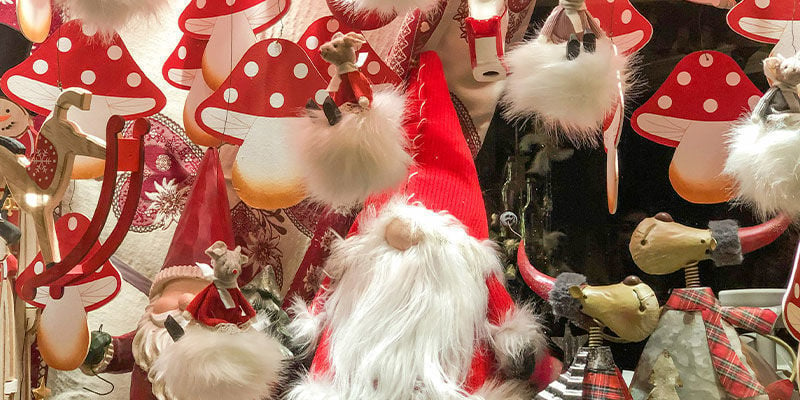
It’s difficult to say how much these traditions have influenced the modern image of Christmas, but it’s difficult to presume that they had no effect. It’s known that such traditions passed into central Europe in various forms, so it’s very possible that certain elements became embedded in other cultural practices associated with the winter solstice, and eventually became inseparable from Christmas as celebrating the holiday became more popular.
Not everyone agrees with these claims, though. Historian Ronald Hutton suspects that certain elements have been amplified in order to fit a specific narrative. He claims that the consumption of fly agaric mushrooms was in fact not as common as many claim, and that shamans did not wear red and white clothes.
However, many others disagree, and so the topic is still very much up for debate.
Where can you find Amanita muscaria?
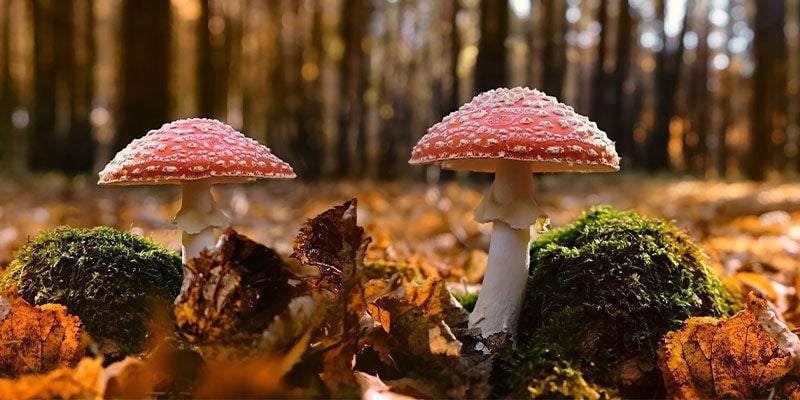
Fly agaric can be found growing among pine, birch, and spruce trees. It appears in early autumn and persists until the first frosts—much like Psilocybe semilanceata.
If you pick it yourself, please do your research beforehand. Many forms of mushrooms can be very dangerous to ingest, including Amanita muscaria. Ensure you know exactly what you’re picking, and how to prepare it, before you consider eating it.
Good luck!
-
 3 min
24 December 2021
Top 5 Christmas Movies For Stoners 2024
Our picks for the top 5 Christmas movies for stoners 2024 are the perfect night in with a fat stash in front of the box this Christmas. The weather outside is frightful, so stay in, get comfortable...
3 min
24 December 2021
Top 5 Christmas Movies For Stoners 2024
Our picks for the top 5 Christmas movies for stoners 2024 are the perfect night in with a fat stash in front of the box this Christmas. The weather outside is frightful, so stay in, get comfortable...
-
 3 min
29 October 2019
Magic Mushrooms Are The Safest Drug
A psilocybin trip can be fun and enlightening, but just how safe is it to trip on magic mushrooms? In this article, we’ll take a deep dive into the world of magic mushrooms, and show you just how...
3 min
29 October 2019
Magic Mushrooms Are The Safest Drug
A psilocybin trip can be fun and enlightening, but just how safe is it to trip on magic mushrooms? In this article, we’ll take a deep dive into the world of magic mushrooms, and show you just how...





 United States
United States












